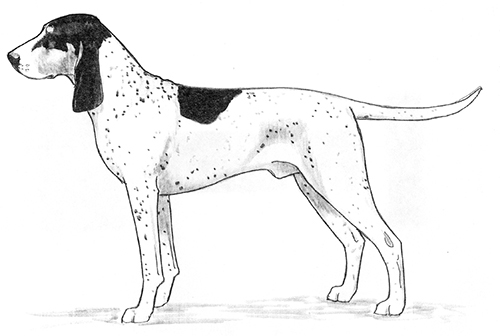Petit Gascon-Saintongeois
Scenthound Group
The goals and purposes of this breed standard include: to furnish guidelines for breeders who wish to maintain the quality of their breed and to improve it; to advance this breed to a state of similarity throughout the world; and to act as a guide for judges.
Breeders and judges have the responsibility to avoid any conditions or exaggerations that are detrimental to the health, welfare, essence and soundness of this breed, and must take the responsibility to see that these are not perpetuated.
Any departure from the following should be considered a fault, and the seriousness with which the fault should be regarded should be in exact proportion to its degree and its effect upon the health and welfare of the dog and on the dog’s ability to perform its traditional work.
History
In essence, the Petit Gascon-Saintongeois is a “reduction” of the Grand Gascon-Saintongeois, individuals of which were undoubtedly mated with Airegeois and other local Briquet hounds to achieve their present size and type. At this time, the Petit Gascon-Saintongeois is one of the most rare hound breeds in France.
The Petit Gascon-Saintongeois was recognized by the United Kennel Club on January 1, 1993.
General Appearance
The Petit Gascon-Saintongeois is bred and judged by the same standard as its parent breed, the Grand Gascon Saintongeois, taking into account that due to a reduction in size, the lines are shorter. Like its parent breed, the Petit Gascon-Saintongeois immediately impresses with its noble air and overall make-up, which serves to combine muscular force with elegance.
The first and immediate impression of a Petit Gascon-Saintongeois should be that of a hound with substance and staying power. Considering the breed's hunting history, individual hounds should have moderate bone and ample muscle. Males are heavier than females. Defects such as bull necks, out at the elbows, loaded shoulders or a beef steer profile should not be confused with masculinity. Likewise, defects such as a shallow muzzle, poorly-formed chest, extremely narrow pelvic region and general frailty should not be confused with femininity.
Because the Petit Gascon-Saintongeois is first and foremost a hunting hound, scars - the result of honorable wounds - shall not be considered faults, nor shall they be penalized by Judges. This includes cuts, nicks, notches on the ears, and/or ears that are frayed at the edges from working in brush, tall grass, etc.
Characteristics
An excellent pack dog with a fine nose, wide casting, and endowed with a sonorous voice. Calm, affectionate and agreeable.
Head
The top lines of the skull and the muzzle are divergent.
SKULL
Seen from the front, the skull is domed and rather narrow. The occiput is well defined. Seen from above, the back of the skull is slightly oval in shape. The stop is only slightly pronounced. The cheeks are lean.
MUZZLE
The muzzle is strong, the same length as the skull, and slightly convex. The lips cover the lower jaw and have closed corners. The edges of the lips are black.
TEETH
A full complement of strong, white, even-fitting teeth meet in a scissors bite.
Disqualifications: Overshot or undershot bite.
EYES
The eyes are oval in shape, and brown in color. The eye rims are black. The expression is gentle and trusting.
Disqualification: Light (yellow) eyes.
NOSE
The nose is always black in color. The nostrils are open and well developed.
Faults: Pink or spotted nose.
EARS
The thin ears are attached very low (below the line of the eye), and well back on the skull. They are well twisted inward and taper to a point. The ear leather length must reach at least to the tip of the nose, and is often longer.
Neck
The neck is of medium length and thickness. It is rounded at the top, with only a slight amount of dewlap below.
Forequarters
The shoulders are long, muscular and moderately oblique.
FORELEGS
The elbows are close to the body. The forearms have strong bone.
Body
The chest is rather broad, long, and deep to the elbow. The ribs are slightly rounded and long. The back is firm and not excessively long. The loin is slightly arched and not too long. The croup is fairly long and slightly sloping. The flank is slightly tucked up.
Hindquarters
The hindquarters are well proportioned.
HIND LEGS
The upper thigh is long and well muscled. The hocks are broad, well angulated and well let down.
Feet
The feet are a slightly elongated oval. The pads and nails are black.
Tail
The long tail is well attached and is carried elegantly in a saber fashion. It is thick at the base and tapers to a point.
Coat and Skin
The coat is short and tight. The skin is supple and not too thick. It is white with black patches.
Disqualification: Any coat other than described in the standard.
Color
White with black patches, sometimes openly speckled or ticked. The cheeks are pale tan and there are tan points above the eyes and traces of tan on the inside of the ears and in the form of specking on the legs. Some fawn hairs may appear on the upper part of the ears. Sometimes at the base of the upper thigh there is a typical dead leaf marking called a ‘roe buck mark’.
Height
Height ranges, measured at the point of the withers, are: males, 22 to 24 inches; females, 21 to 23 inches.
Disqualifications
(A dog with a Disqualification must not be considered for placement in a conformation event, and must be reported to UKC.)
Unilateral or bilateral cryptorchid.
Viciousness or extreme shyness.
Albinism.
Overshot or undershot bite.
Light (yellow) eyes.
Any coat other than described in the standard.

Looking for a Dog?
Find a dog that will fit your family.
Note: The breeders on this list are not endorsed by UKC.
Revised January 1,2009
©Copyright 1993, United Kennel Club
